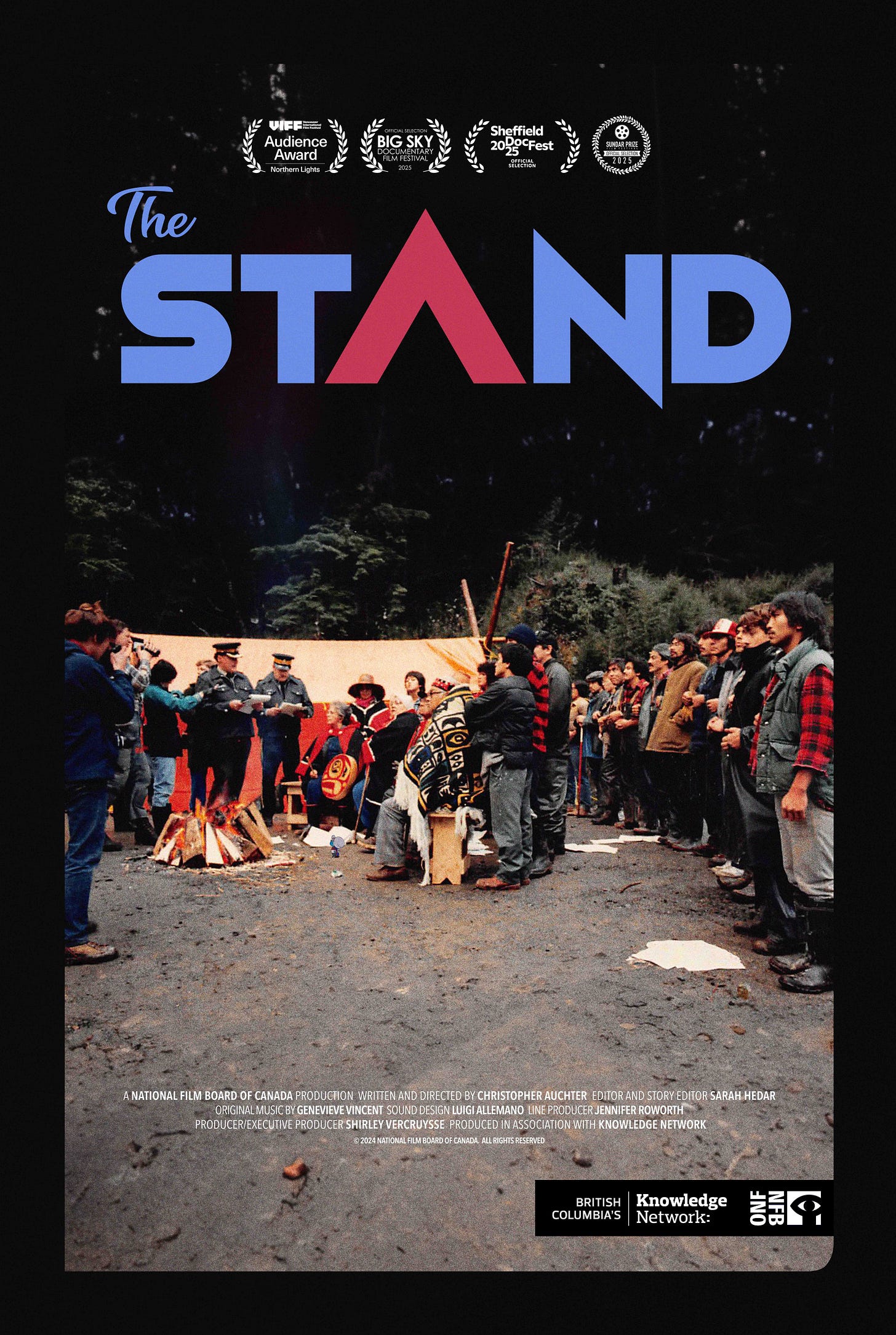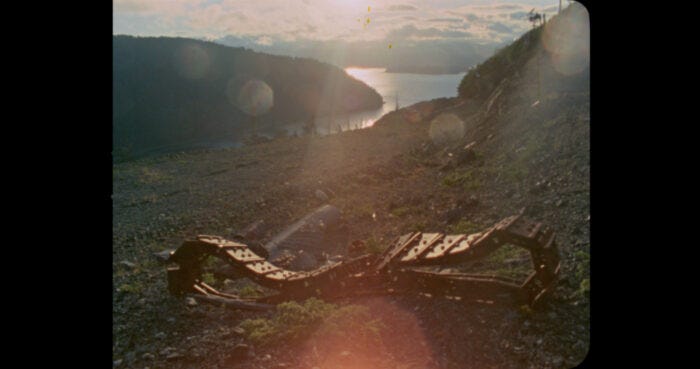The Stand
In 1985, the Haida nations stood in the path of destruction and changed the course of Canadian history. This timely NFB release reminds us all why it's time to take a stand to ensure we have a future.
Poster for The Stand Credit: National Film Board of Canada
Robin Wall Kimmerer is an environmental biology professor, enrolled member of the Citizen Potawatomi Nation, founder of the Center for Native Peoples and the Environment and author of Braiding Sweetgrass: Indigenous Wisdom, Scientific Knowledge, and the Teachings of Plants.
In the first chapter titled, Skywoman Falling, Kimmerer shares the origins story that’s told throughout the Great Lakes region. Skywoman descends from the Skyworld towards dark waters below. Geese rise up to break her fall and hold her aloft. The great turtle offers its back for her to rest on before muskrat gives his life to bring a handful of mud from deep below the water for Skywoman to plant the fruits and seeds she brought with her from the Tree of Life. Together Skywoman and all of the creatures create a world where people, animals and plants thrive together rooted in the principles of reciprocity, gratitude, and abundance. That was a heavily abridge version.
Kimmerer points out the origin story celebrates life as well as sharing and working together to build a beautiful, life-sustaining world. That caring and sharing is not reflected in Christianity’s origin story found in the book of Genesis where midway through the book, Eve is banished from the Garden of Eden for eating from the tree of knowledge of good and evil. That act gave rise to the concept of moral judgement and the choice between obedience and disobedience to God. Perhaps these differences have something to do with the First Nation’s origin story being filtered through a female lens while the biblical creation story is told through a male gaze. The bible punishes Eve forcing her to live a life of labour and hardship under her husband’s rule. Men also control every living thing in the natural world because man is considered superior in the evolutionary hierarchy.
“But in Native ways of knowing, human people are often referred to as “the younger brothers of Creation.” We say that humans have the least experience with how to live and thus the most to learn – we must look to our teachers among the other species for guidance. Their wisdom is apparent in the way that they live. They teach us by example. They’ve been on the earth far longer than we have been, and have had time to figure things out. They live both above and below ground, joining Skyworld to the earth. Plants know how to make food and medicine from light and water, and then they give it away.” – Kimmerer, Braiding Sweetgrass pgs. 9 and 10.
Kimmerer imagines that, “When Skywoman scattered her handful of seed across Turtle Island, she was sowing sustenance for the body, mind, emotion and spirit: she was leaving us teachers. The plants can tell us her story, we need to learn to listen.” – Kimmerer, Braiding Sweetgrass pg. 10.
On the other side of the country, the Haida have been trying, since first contact, to help settlers respect the intrinsic value — not just the monetary value — of the old growth trees and native plants growing on their unceded lands which are rich in unique biodiversity. The Haida have been listening to the forests, the trees and all of the creations sharing their earth, water and sky. The Haida have also been sharing their knowledge trying to teach settlers to listen too. But that can be challenging to say the least.
British Columbia joined confederation on July 20, 1871 and for close to a century the provincial and federal governments worked to destroy Haida culture while stripping the land of its natural resources.
The Haida knew clear-cutting ravaged old-growth forest and believed that was responsible for the November 1984 landslide that wiped out Landrick Creek on Graham Island, destroying the salmon spawning grounds. Instead of listening to their concerns, the provincial government approved new logging permits that threatened ancestral lands and salmon streams. This was their call to action and in the fall of 1985, a small group of Haida blockaded a dirt road on Lyell Island demanding a moratorium on clear-cut logging practices.
Frank Beban Logging Ltd., subcontractor for Western Forest Products Inc. (WFP), found itself in a standoff with Haida Gwaii Land Defenders. WFP championed capitalism and economic growth while the Haida fought for spiritualism, the environment and a sustainable, livable future.
Haida Elders Credit: National Film Board of Canada
The logging company lost no time getting a court injunction. The Land Defenders refused to move and found themselves in contempt of court. That’s when the Land Defenders called in the big guns in the form of Haida Elders who stood their ground blocking the logging road. The Elders were the first arrests made by Royal Canadian Mounted Police (RCMP) officers with the total reaching 72 arrests between November 16 and 29, 1985.
Allies of the Haida Gwaii included David Suzuki and then-NDP MP Svend Robinson. Robinson spent time at the camp, stood in solidarity with Haida Gwaii Land Defenders and was one of the folks arrested.
Scottish-Canadian journalist, Jack Webster, played a loud, abrasive and questionable role in media’s coverage of the blockade. Webster, who comes across as the Don Cherry or Tucker Carlson of his time, enjoyed stirring the pot, tried to force words into people’s mouths and routinely interrupted and cut off Haida leader Miles Richardson, as well as allies, who appeared on his BCTV program Webster! Considered by some to be the "king of the Vancouver airwaves,” Webster comes across just like every other European monarch expounding his paternalistic, white supremacist arrogance with over bearing bluster that would most certainly play to a certain demographic ensuring high ratings, while spectacularly failing to provide a fulsome, balanced picture of the peaceful blockade on Lyell Island.
Webster’s journalistic integrity seemingly went unchallenged and unscathed in any meaningful way after it became common knowledge that he, along with BC’s Energy Minister Stephen Rogers and BC’s Forestry Minister Tom Waterland, had shares in WPF.
Haida Gwaii Land Defenders with ally Svend Robinson in blue jacket Credit: National Film Board of Canada
Meanwhile, Land Defenders called for the provincial and federal governments to work with Indigenous people to find a way to protect the land and the future. Those involved in the process included BC Premier William Bennet; Federal Minister of Indian Affairs and Northern Development, David Crombie; and Prime Minister Brian Mulroney.
Drawn from over a hundred hours of archival footage and audio, award-winning director Christopher Auchter recreates the courage, tenacity and tension of this pivotal moment in history. From furious showdowns between Webster and Haida leader Miles Richardson, to the support of then-NDP MP Svend Robinson, The Stand captures the struggle as it unfolds moment-to-moment.
Haida leader Miles Richardson Credit: National Film Board of Canada
As a complex battle played out on remote logging roads, in the legal system and in the court of public opinion, authorities staged a steady propaganda campaign, alongside stalling tactics and an RCMP presence, to undermine the Haida cause. With the whole world watching, the Haida hold fast to their strategy of peaceful resistance even inviting the loggers and their families to share a meal at the Land Defenders’ camp.
The blockade lasted three months, but it would take until July 1987 for the underpinning issues to finally be addressed when the Canadian and BC governments signed a memorandum of agreement creating Gwaii Haanas National Park Reserve, a UNESCO World Heritage Centre that effectively ended logging operations and protected the area.
The parallels between this historic event and current political policy and kowtowing to corporations are many. I’m thinking of the Ford government’s Bill 5, Protect Ontario by Unleashing our Economy Act, 2025, which by-passes meaningful consultation with northern Ontario First Nations while creating economic zones exempt from archaeological and environmental assessments. Of course, there’s also Prime Minister Carney’s Bill C-5, An Act to enact the Free Trade and Labour Mobility in Canada Act and the Building Canada Act the federal counterpart of Ford’s bill.
The Lyell Island blockade laid the foundations for current land-claim treaties across Canada. From the Haida Nation’s resolute act of vision and conscience emerged an unbreakable commitment to justice, solidarity and Indigenous sovereignty that echoes to this day.
Haida Gwaii totem poles returning to the land Credit: National Film Board of Canada
Archaeological findings show that the approximately 150 islands that make up the archipelago have been continuously inhabited for between 6,000 and 8,000 years. For 223 years, Haida Gwaii was known as the Queen Charlotte Islands after British explorer George Dixon named the area for the wife of King George III in 1787. On June 3, 2010 the archipelago was officially renamed Haida Gwaii when legislation received royal assent formalizing the name change.
Vestiges of the logging industry on Lyell Island Credit: National Film Board of Canada
The Stand writer and director, Christopher Auchter, grew up roaming the beaches and forests of the Haida Gwaii archipelago off Canada’s West Coast, and his art is rooted in the land and stories of the Haida people. Auchter’s art practice is fuelled by his close connection to the natural environment, his adventures in forestry and commercial fishing, and the colourful people with whom he has lived and worked. From early on, he recorded his feelings and impressions as images, and today his filmmaking serves the same function.
To date, Auchter has directed four films with the NFB including the award-winning animated short The Mountain of SGaana (2017/10 mins) and the short doc Now Is the Time (2019/16 mins), a Sundance, TIFF and NYT Op-Docs selection. Most recently, Auchter’s feature doc The Stand (2024/1hr 34 mins) received the Audience Award, Northern Lights program, at the Vancouver International Film Festival (VIFF).
Auchter’s credits also include Daniel Janke’s How People Got Fire (2008/16 mins), Electronic Arts’ NHL Games and Nintendo’s Punch Out! He has illustrated three children’s books including Jordan Wheeler’s Just a Walk, a comic by Richard Van Camp called Kiss Me Deadly and a graphic novel by W.L. Liberman entitled The Ruptured Sky: The War of 1812.
The Stand (2024/1hr 34 mins) is available free on the NFB website.
Thanks to everyone who read today’s article. With your continued financial support, a little Nicoll can make a lot of change.








